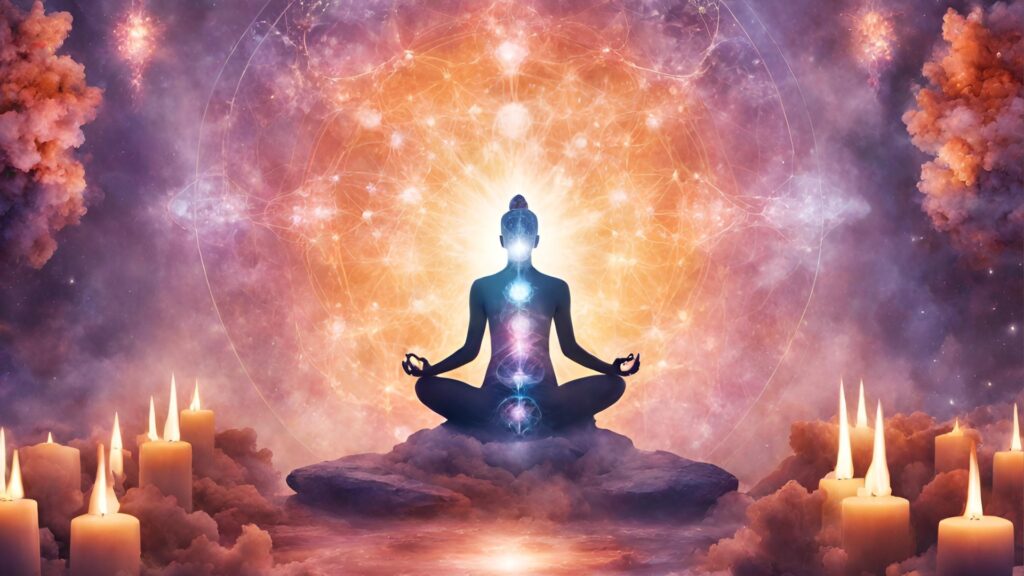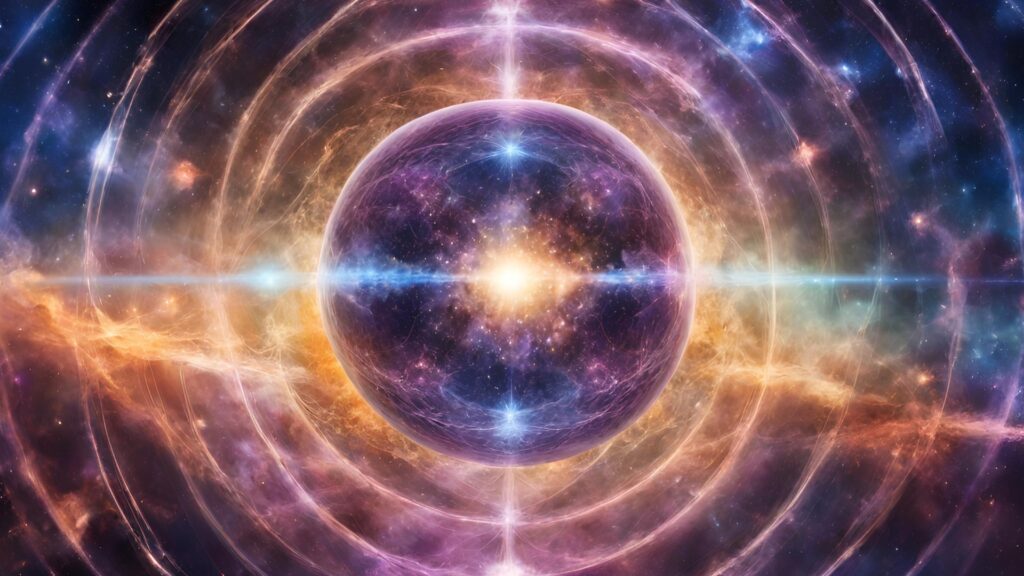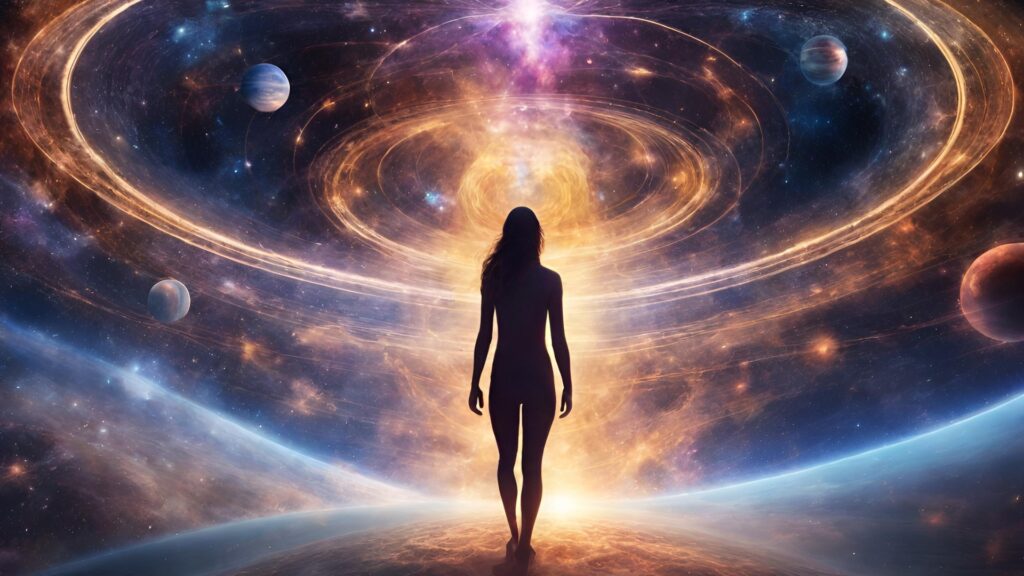
We see that just as Eastern philosophies as well as references in Western philosophy and theology have claimed, through an inquiry of the physical evidence of reality, that we are all connected and all one. Physics has demonstrated that quanta are the indivisible components of the physical, making up the components of atoms. This interpretation of the physical through a lens of quantum theory reveals as explained in “We Do Not and Cannot Sit on a Chair”, for example, that even though solid as a chair may seem, that rather than sitting on it, we are actually hovering 10-8 cm over the chair on a repelling force of electrons in energetic exchanges that exist beyond our perceptions. (Kaku youtube.com). Rather than viewing atoms as a solid nucleus with circulating matter of protons and neutrons, it is currently understood more as fields of energy, that make up greater forms of complexity not by some type of binding glue, but as electromagnetic forces that attract or repel at different strengths.
To visualize this, at the most sub-atomic level, we would see anything that exists, be that a tree, bird, herd, human, or any organism, system or environment; can be broken down to groups of cells, made up of groups of molecules, from groups of atoms, which are made by the particles and waves of quanta. Individually and collectively, it is all held together with a field of vibrational force with space between each connecting quanta. If we consider thoughts as information, perhaps it is the waves of energy in the quantum vacuum that record and carry this information as described by the Akashic Field of ancient texts or if preferred, the Zero Point Field of quantum physics. Through systematic training of conscious direction, we strengthen our ability to tap into, communicate and optimize our intake of information from such a field. It is in the multitude of potential parallels that exist, that the consciousness of an observer can bring any of the suspended realities into the one that we collectively share.
To comprehend this entanglement between an organism and the environment, consider Lipton’s explanation of genes as an environmentally adaptive blueprint for an organism. He references experiments by Michael Levin that demonstrate forces outside of the organism instantly triggering a rearrangement or hyper-mutation within genetic structures, even passing some adaptive responses on to offspring. The extraordinary effect of how simply the magnitude of bioelectrical volts given to tadpole cells, so drastically translates into changes in the general anatomical structure of the future frog in such experiments, exemplifies the crucial role of energy as a flow of function for living beings. (Lipton 76)
Church also discusses the dramatic effects that historical events and cultural changes can be graphed in correlation to shifts in the electromagnetism of the Earth and energetic radiation of solar activity, showing a strong correlation with such changes and hyper-mutations in biological organisms. (Church Chapter 5)
In considering everything as interconnected and that All is one, Lipton offers a better understanding of the commonalities among all of Earth’s organisms, in the striking commonalities in number of genes, or nucleotide sequences within a chromosome, among all organisms. From worm, to mouse, monkey, human being, having essentially the same underlying structure, varying in how those genes are expressed and the mechanism for that variety in the electromagnetic response of regulatory proteins. (Lipton 40)

As stated by Lipton, although, or perhaps because we are made of 50 trillion cells, we should consider an organism as one large embodied cell expressing the same responses to the environment as a cell, in which it will move towards what is beneficial (such as nutrients or minerals), away from what is harmful (such as a toxin), or remain neutral, and glean some insight into more intangible environmental conditions. (Lipton 149-50). Lipton expands further in the Audible version of “Biology of Belief,” considering for example love as the highest, most sought emotional human state and stress as the least sought or most dreaded.
A case sample of orphanages in Romania that were the subjects of multiple studies, demonstrates this, and can shed some light. Under a religious persuasion to carry out a birth; babies, whether or not the parents could afford, wanted, or were willing to raise, led to the need for many orphanages, which show that although these children had sufficient food, shelter, education; the only thing lacking for them was love, to the degree that a parent would love their child. In a biological assessment of these children, all of their vital statistics were suppressed by 30% or more, with a high rate of Autism. The environmental factor in the case of Autism in these orphans, prompted the turn inward as a response to conditions lacking of love.
As for stress on the other hand, for the most part, every disease or virus is essentially genetically imprinted in us all through the evolution of our ancestry, but are kept in check by the immune system. Ideally, blood flow would be denoted mostly to energy production, growth, immunity and so forth. Under stress, these are suppressed in fueling protective functions. Under chronic conditions, this leads to all of the ailments we increasingly hear about being associated with stress, to unleash and flourish. The reason being that stress suppresses immunity performance, allowing the opportunistic organisms already in our systems to reproduce and get the opportunity to reek havoc and become expressed with less resistance. Another side effect of the stress-response is that our intelligence is diminished as more energy is sent to instinctual reactions by restricting blood flow to the brain.
The Biology of Belief 10th Anniversary Edition: Unleashing the Power of Consciousness, Matter & Miracles by Bruce H. Lipton
Dive into ‘The Biology of Belief’ and explore the incredible influence of consciousness on your health and life.
These drivers arising from the environment, which are behind the functioning for the human organism are instinct programmed into the gene and sub-conscious, which records the experience or stimulus. Consciousness however, can observe these processes and pre-determine functional operations. This has been shown in multiple studies of meditators controlling their own heart rhythms, blood flow, body temperature and so on, while in a meditative state. (Lipton Chapter 2)
So as Lipton suggests, we are not determined genetic organisms, stuck. Perception can adjust the biology. At the level of a human, we have a brain filled with a trillion cells, that lies between the world that we see and experience and the internal world of our biology. The function of the brain is perception, to read the world and then adjust the biology accordingly. Perception is distinguished in two parts, the conscious and the subconscious. The initial blueprint of our genes comes to us not as a clean slate, but programmed from the very beginning by the environment of a mother’s diet, emotions, and thoughts. We’ve downloaded the nutrients, emotions, the chemical experiences that we shared with our parents since even before the sperm or the womb. This initial programming is equally through our genetics and the environment.

Although such programming empowers the subconscious to essentially drive the majority of our response and activity, what is relevant is the conscious mind right now, rather than dredging up and reliving the programming of deficit. Buddhist mindfulness or any conscious mental practice is a way to get to a point of being in conscious control. Lipton also offers contemporary modalities of Energy Psychology, for super-learning to open up the brain and download information at phenomenal rates using various emerging models. Modalities such as PYSCH-K work by harnessing the conscious mind as the tool to alter the subconscious to reprogram ourselves and change beliefs in as rapidly as 10 minutes.
Consciousness has better things to do than to control simple tasks like walking, digesting and so on. Directing the consciousness then can gain clear benefits to biology, psychology, society, quanta, and essentially, everything in each of our existence. From the embryo state to the natural world, nature has predicted the environment in the evolution of living things. Knowing that stress, happiness, any state or emotion has a biological effect of chemical processes and reactions like dopamine, cortisol and so forth, we see that even the environment of a womb will carry information that begins to affect the blueprint of the genetic map before birth. So how we see the world, the perception of the organism, is the catalyst for alteration of the genes. If we were a machine, our control mechanism would be consciousness, so that thought can be considered a mechanism for interpreting signals from the environment. (Lipton Chapter 3).
As Dr Paul Masters, professor and founder of the University of Metaphysics explains it, the personal subconsciousness is a memory bank that is filled with the accumulation of thought and experience interpretation, whether positive or negative to fill the records of this bank, thus laying the groundwork for future expectations. (Masters, Master’s Degree Curriculum 1: 22) Further, he states that the simplest means of countering the governance of this established sub-conscious belief system to work for us rather than against us, is simply through positive thinking. (Masters, Master’s Degree Curriculum 1: 24).
Consciousness then is the key to altering the physical world, beginning most directly with ourselves and our own physical systems. As we inwardly think, we outwardly reflect, as a direct response of the environmental conditions that perception arises from. Meditation is the key to unlocking this world beginning with how we perceive and respond to our own health or ailments. Beyond this there is a knowledge that can and has been attained through a connection to an informational whole that has added benefit to compliment knowledge attained from the physical world.
The Tao of Physics: An Exploration of the Parallels Between Modern Physics and Eastern Mysticism by Fritjov Capra
A Mind-Bending bridge through the gap between science and mysticism, unveiling the astonishing harmony between Eastern wisdom and modern physics.
In the Tao of Physics, Capra compares both Tao and Physics, as both are concerned with the underlying principals of the Universe. He acknowledges the difference between the nature of knowledge and the language in which knowledge is expressed in order to provide a framework of comparison. (Capra 26-29). Capra describes East/West differences to include the valuation of rational thought processes over intuition in the West along with the use of equations and complex mathematical formulas to the difference of valuation for intuition and use of meditation practice as a method of attaining knowledge used widely in the East (Capra 30-33). He explains that what parcels out from these methods is a conceptual representation of reality on one hand through the methods of the West, and an experiential reality from the East. Although with both methods, it may take years of training to acquire comparable knowledge, through meditation it is based on direct insights of natural phenomena while in physics it is based on observations of the natural world (Capra 34-37). Overall, Capra concludes that the innate ambiguities accompanying language or even the symbols of mathematics to convey knowledge cannot offer the same degree of insight as an experience of knowledge can convey. (Capra 45-48.) By broadening our perception of the value of gaining insights through experiential methods like meditation, we can more fully directly comprehend the working of our Universe and gain that knowledge directly through independent inquiry.
Beyond our own individual awareness, several studies have also proposed an awareness to much more in our seemingly inanimate environment. Author Ziad Masri, in “Reality Unveiled” points to research carried out by former CIA agent, Cleve Backster, who was surprised by his own results of connecting plants to a polygraph. In the very first experiment, he noted how the plant registered an increase in stimulus detected by the equipment when he simply had the thought of burning it. Upon actually retrieving matches and carrying out the intention, increased activity from the plant registered in the equipment until the burning ceased.
Reality Unveiled: The Hidden Keys of Existence That Will Transform Your Life by Ziad Masri
Take a profound journey into the heart of existence, revealing a breathtaking, hidden reality that will transform you. Far from offering simple platitudes and general principles, Reality Unveiled immerses you into this surprising world of ancient and modern knowledge—presenting all the incredible evidence to support it.
Masri also references other similar evidence of plant sentience documented in publications such as, “The Secret Lives of Plants”, showing that the growth of plants can be stunted or aided by the intention of human thought. (Masri Chapter 3) Masri also connects to such awareness of non-living elements in the environment as he references through the work of Dr. Masaru Emoto, detailed in “The Hidden Messages of Water”. Through high-speed photography, water molecules can be seen to take on complex structures of crystallization or broken fragmented forms according to thoughts directly sent to the examined molecular structures of the water. Various results from types of music, words, thoughts and even the transformation of contaminated water into crystalline form following mediation and prayer, was observed and recorded. (Masri Chapter 2)
The Hidden Messages in Water by Masaru Emoto
In this New York Times bestseller, internationally renowned Japanese scientist Masaru Emoto shows how the influence of our thoughts, words and feelings on molecules of water can positively impact the earth and our personal health.
The relevance of this goes beyond the fact that humans are made-up of ~60% water, but also to demonstrate an intrinsic entanglement that lies in all that exists and remains as a remnant feature of our initial connection before the big bang. With the inclusion of cosmic consciousness, philosophies of astrology contend that in the age of Aquarius, we are entering an age of information. Could it be that at this point in our human cycle, human consciousness is set to unfold into the interstellar reaches beyond the individual and into a collective awakening of our personal connections with the field that essentially carries the information of all that exists?




